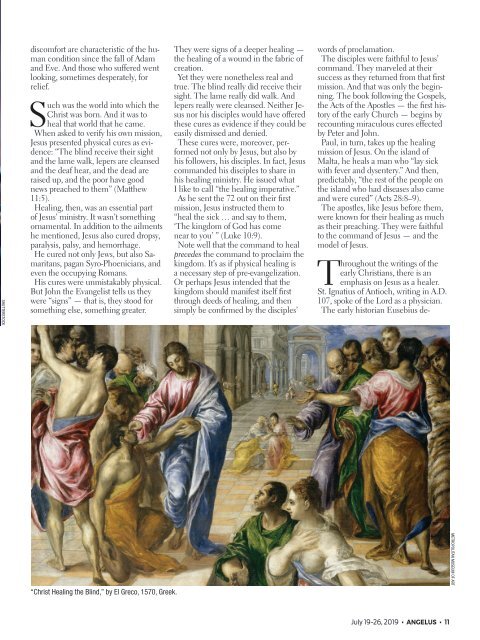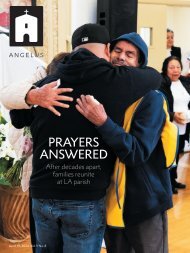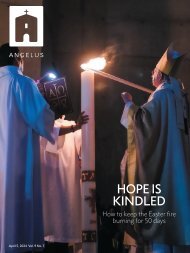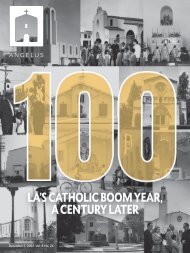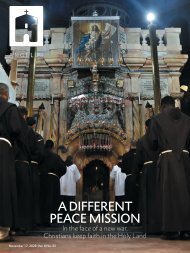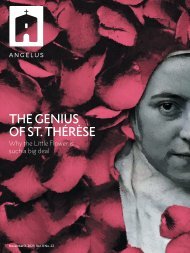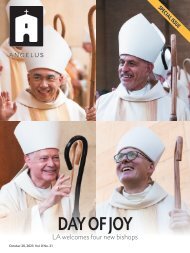Angelus News | July 19-26, 2019 | Vol. 4 No. 26
A 12th-century Byzantine mosaic depicts the Gospel story of Jairus asking Jesus to heal his dying 12-year-old daughter. For two millennia, the Catholic Church has been in the business of treating spiritual ailments — but that doesn’t mean it’s ignored people’s physical ailments. In fact, the world has Christianity and its founder to thank for some of the foundational principles of modern medicine. On Page 10, contributing editor Mike Aquilina tells the story of how the countercultural beliefs of early Christians led to one of society’s greatest inventions, the hospital. On Page 14, Angelus’ R.W. Dellinger tells the story of how a home hospice nurse is living out Jesus’ healing imperative by accompanying patients in their final moments.
A 12th-century Byzantine mosaic depicts the Gospel story of Jairus asking Jesus to heal his dying 12-year-old daughter. For two millennia, the Catholic Church has been in the business of treating spiritual ailments — but that doesn’t mean it’s ignored people’s physical ailments. In fact, the world has Christianity and its founder to thank for some of the foundational principles of modern medicine. On Page 10, contributing editor Mike Aquilina tells the story of how the countercultural beliefs of early Christians led to one of society’s greatest inventions, the hospital. On Page 14, Angelus’ R.W. Dellinger tells the story of how a home hospice nurse is living out Jesus’ healing imperative by accompanying patients in their final moments.
You also want an ePaper? Increase the reach of your titles
YUMPU automatically turns print PDFs into web optimized ePapers that Google loves.
SHUTTERSTOCK<br />
discomfort are characteristic of the human<br />
condition since the fall of Adam<br />
and Eve. And those who suffered went<br />
looking, sometimes desperately, for<br />
relief.<br />
Such was the world into which the<br />
Christ was born. And it was to<br />
heal that world that he came.<br />
When asked to verify his own mission,<br />
Jesus presented physical cures as evidence:<br />
“The blind receive their sight<br />
and the lame walk, lepers are cleansed<br />
and the deaf hear, and the dead are<br />
raised up, and the poor have good<br />
news preached to them” (Matthew<br />
11:5).<br />
Healing, then, was an essential part<br />
of Jesus’ ministry. It wasn’t something<br />
ornamental. In addition to the ailments<br />
he mentioned, Jesus also cured dropsy,<br />
paralysis, palsy, and hemorrhage.<br />
He cured not only Jews, but also Samaritans,<br />
pagan Syro-Phoenicians, and<br />
even the occupying Romans.<br />
His cures were unmistakably physical.<br />
But John the Evangelist tells us they<br />
were “signs” — that is, they stood for<br />
something else, something greater.<br />
They were signs of a deeper healing —<br />
the healing of a wound in the fabric of<br />
creation.<br />
Yet they were nonetheless real and<br />
true. The blind really did receive their<br />
sight. The lame really did walk. And<br />
lepers really were cleansed. Neither Jesus<br />
nor his disciples would have offered<br />
these cures as evidence if they could be<br />
easily dismissed and denied.<br />
These cures were, moreover, performed<br />
not only by Jesus, but also by<br />
his followers, his disciples. In fact, Jesus<br />
commanded his disciples to share in<br />
his healing ministry. He issued what<br />
I like to call “the healing imperative.”<br />
As he sent the 72 out on their first<br />
mission, Jesus instructed them to<br />
“heal the sick … and say to them,<br />
‘The kingdom of God has come<br />
near to you’ ” (Luke 10:9).<br />
<strong>No</strong>te well that the command to heal<br />
precedes the command to proclaim the<br />
kingdom. It’s as if physical healing is<br />
a necessary step of pre-evangelization.<br />
Or perhaps Jesus intended that the<br />
kingdom should manifest itself first<br />
through deeds of healing, and then<br />
simply be confirmed by the disciples’<br />
words of proclamation.<br />
The disciples were faithful to Jesus’<br />
command. They marveled at their<br />
success as they returned from that first<br />
mission. And that was only the beginning.<br />
The book following the Gospels,<br />
the Acts of the Apostles — the first history<br />
of the early Church — begins by<br />
recounting miraculous cures effected<br />
by Peter and John.<br />
Paul, in turn, takes up the healing<br />
mission of Jesus. On the island of<br />
Malta, he heals a man who “lay sick<br />
with fever and dysentery.” And then,<br />
predictably, “the rest of the people on<br />
the island who had diseases also came<br />
and were cured” (Acts 28:8–9).<br />
The apostles, like Jesus before them,<br />
were known for their healing as much<br />
as their preaching. They were faithful<br />
to the command of Jesus — and the<br />
model of Jesus.<br />
Throughout the writings of the<br />
early Christians, there is an<br />
emphasis on Jesus as a healer.<br />
St. Ignatius of Antioch, writing in A.D.<br />
107, spoke of the Lord as a physician.<br />
The early historian Eusebius de-<br />
“Christ Healing the Blind,” by El Greco, 1570, Greek.<br />
METROPOLITAN MUSEUM OF ART<br />
<strong>July</strong> <strong>19</strong>-<strong>26</strong>, 20<strong>19</strong> • ANGELUS • 11


